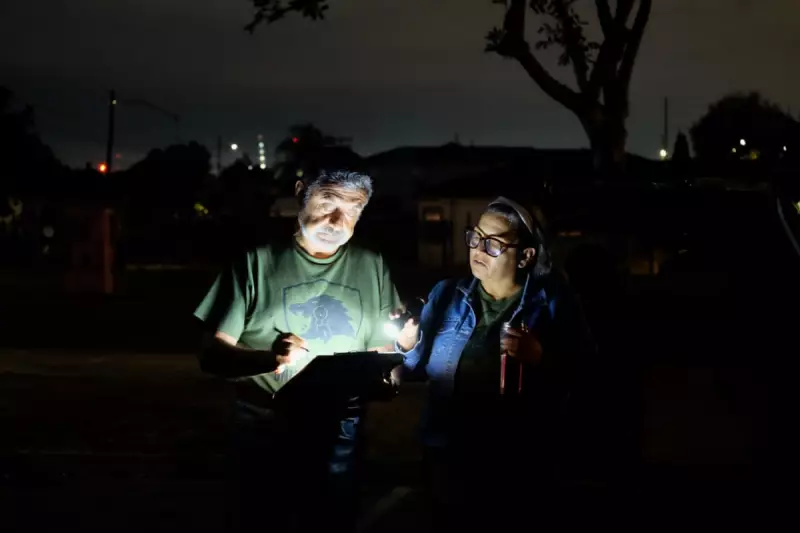
In the pre-dawn darkness of southern San Diego, three educators sip coffee and discuss their teaching jobs while driving through quiet residential streets. But this is no ordinary commute – they're conducting surveillance for undercover immigration agents, part of a growing movement of teachers turned activists protecting their vulnerable students.
The Dawn Patrol: Educators on Immigration Watch
During an October morning patrol, the teachers' trained eyes spotted what most would miss: a grey Dodge Durango with completely tinted windows, a small strip of lights near the front, and a visible steel prisoner partition inside. When the driver picked up a handheld radio, their suspicions were confirmed.
High school teacher Marysol Duran immediately activated her walkie-talkie, reporting to other members of her unit: "We have identified a potential. He is on 39th and Gamma. We will keep close watch."
Duran and her colleagues belong to the Association of Raza Educators, a group of activist teachers who regularly patrol southern California neighbourhoods monitoring Immigration and Customs Enforcement (ICE) activity. When they identify undercover agents – who may be conducting surveillance or planning arrests – they alert the community through social media, group chats, and sometimes a megaphone.
Why Schools Have Become Ground Zero
The teachers' choice to patrol near half a dozen local schools was deliberate. Just two months earlier, at least four parents were arrested or detained by immigration officials near schools in San Diego county alone. In one particularly distressing incident outside a Chula Vista elementary school, an undocumented mother was arrested during morning drop-offs as her children watched from the car.
This represents a significant shift in immigration enforcement. Although children in the US have the right to free public education regardless of citizenship status, the Department of Homeland Security rescinded Obama and Biden-era guidelines earlier this year that previously limited arrests in "sensitive locations" like schools and churches.
When the teachers spotted the suspected ICE vehicle in October, they immediately gave chase. From the driver's seat, high school counsellor Juan Orozco pursued the Dodge while Duran provided live updates in Spanish and English via social media. Elementary school teacher Aremi Lopez stood ready with a megaphone in the backseat.
The Human Cost: Students Living in Fear
The impact on students and families across southern California has been profound. Fear reached new heights after the Supreme Court ruled earlier this fall that federal agents can stop and detain residents in Los Angeles simply for speaking Spanish, appearing Latino, or working certain types of jobs.
"We live in a state of fear, [whether you're a] citizen or not a citizen: plumber, professional, mother, grandma, everyone," Orozco said. "And we shouldn't live like that."
This fear manifests in tangible ways – Orozco reports instances where students don't come to school because they or their parents are too frightened to leave home.
The story of two sisters, Azda and Guadalupe (names changed to protect their identities), illustrates the human toll. While 14-year-old Azda is a US citizen, her 19-year-old sister Guadalupe is undocumented, as is their mother. They've lived with contingency plans for what happens if ICE detains their mother – they would need to immediately seek help from relatives and potentially "flee together" back to Mexico.
Even their four-year-old brother has absorbed the language of resistance, sometimes chanting around the house: "La migra, why are you here?"
A Long History of Resistance
San Diego has witnessed dramatically increased immigration activity in 2025, with three times as many people arrested by ICE in just the first half of this year compared to all of 2024, according to NBC reports. More than 50% of these arrests involved people with no criminal convictions.
But this fear isn't new to San Diego's immigrant community. Unión del Barrio, the political organization that founded the Association of Raza Educators, began conducting community patrols to monitor law enforcement over three decades ago. Orozco himself experienced what he believes was immigration enforcement profiling as a child in the early 1980s, when agents in an unmarked van detained him at a bus stop and only released him after he recited the Pledge of Allegiance.
Despite eventually losing track of the suspected ICE vehicle during their October patrol, the teachers found some satisfaction in their efforts. "There's the relief that although we did lose [the vehicle], we did at least change their plans," Duran noted. "And they might not have had the luck to execute whatever they were expecting to."
Glimmers of Hope and Continued Challenges
Some policy developments offer hope. In late October, the San Diego City Council moved forward with an ordinance that would require federal law enforcement to obtain judicial warrants to access non-public areas of city-controlled property, including the inside of city-run public schools. Another similar law passed at the state level in September.
However, immigrant rights advocates remain concerned about the potential impact of Trump's One Big Beautiful Bill Act, which allocated billions to hire up to 10,000 new immigration officers across the US.
As the teachers concluded their morning patrol and watched parents walking children to a nearby elementary school, Duran reflected: "You see the beauty of our community just doing what any other human being would do in the United States: Taking their children to school because they have the right to a free education."
By 7am, the educators had packed their surveillance equipment – mounted car cameras, walkie-talkies, and megaphones. They needed to hurry to their real jobs – the school day was about to begin.





